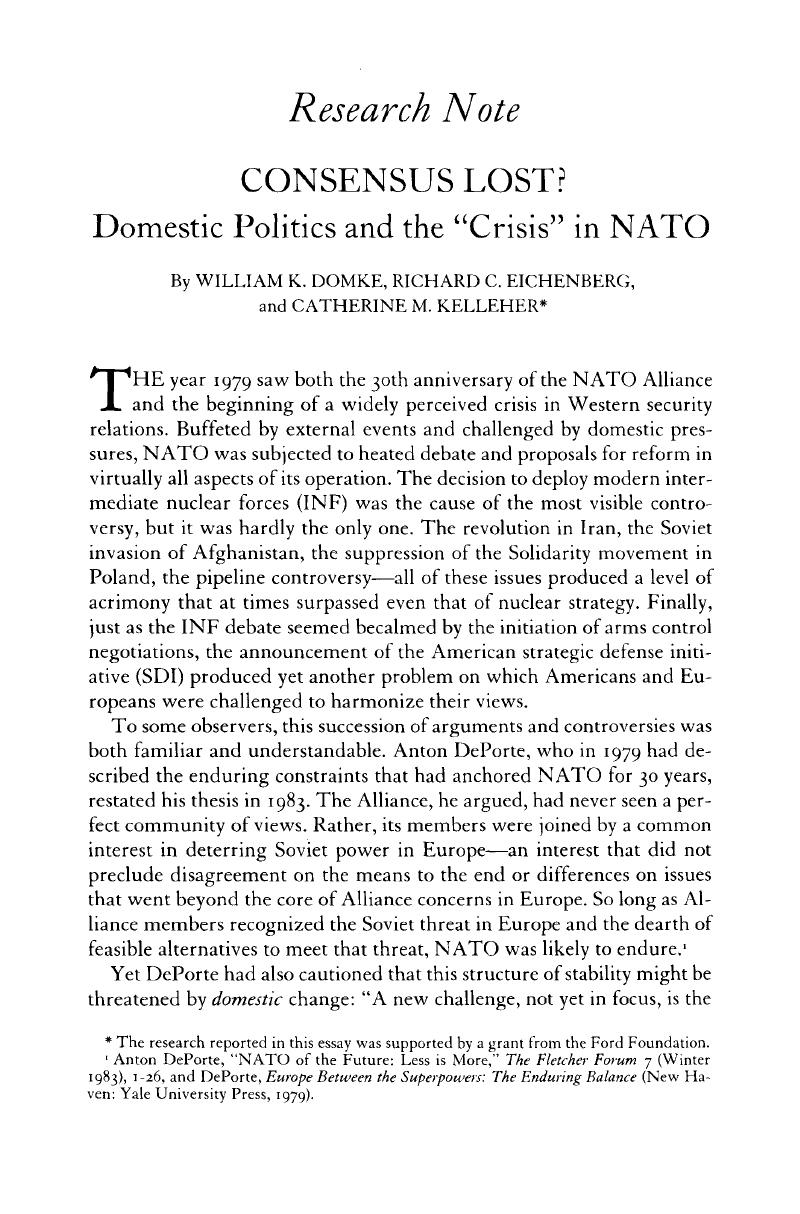Article contents
Consensus Lost? Domestic Politics and the “Crisis” in NATO
Published online by Cambridge University Press: 13 June 2011
Abstract

- Type
- Research Note
- Information
- Copyright
- Copyright © Trustees of Princeton University 1977
References
1 DePorte, Anton, “NATO of the Future: Less is More,” The Fletcher Forum 7 (Winter 1983), 1–26Google Scholar, and DePorte, , Europe Between the Superpowers: The Enduring Balance (New Haven: Yale University Press, 1979)Google Scholar.
2 Ibid., 243.
3 Freedman, , “NATO Myths,” Foreign Policy, No. 45 (Winter 1982), 48Google Scholar.
4 Flynn, Gregory and Rattinger, Hans, eds., The Public and Atlantic Defense (Totowa, NJ: Rowman & Allanheld, 1985), 381Google Scholar.
5 Laqueur, Walter, “Hollanditis: A New Stage of European Neutralism,” Commentary 72 (August 19, 1981), 19–26Google Scholar.
6 William Schneider, “Peace and Strength: American Public Opinion on National Security,” in Flynn and Rattinger (fn. 4), 339, 356; Watts, William and Free, Lloyd, “Internationalism Comes of Age … Again,” Public Opinion 3 (March/April 1980), 47Google Scholar.
7 The most explicit analysis along these lines is Joffe, Joseph, “Europe's American Pacifier,” Foreign Policy, No. 54 (Spring 1984), 64–82CrossRefGoogle Scholar.
8 The figures in the preceding paragraph are taken from Flynn and Rattinger (fn. 4), 61, 167, 94; and from Netherlands Institute for Public Opinion [NIPO], Bericht No. 2112 (Amiterdam, April 1981)Google Scholar.
9 See Ingelhart, Ronald, The Silent Revolution: Changing Values and Political Styles Among Postwar Europeans (Princeton: Princeton University Press, 1977)Google Scholar, and Szabo, Stephen, ed., The Successor Generation (London: Butterworth's, 1983)Google Scholar.
10 In subsamples of this size, differences of about 15 percentage points are statistically significant.
11 See, for example, the two polls reported in Public Opinion 6 (February/March 1983), 6Google Scholar.
12 The most emphatic statement of this interpretation is DePorte (fn. 1, 1979).
13 As noted in fn. 10, caution is warranted when comparing very small subsamples. These differences, averaging about 10%, are not statistically significant. Nonetheless, the pattern shows up in other surveys as well, and the left-right distribution noted below is consistent.
14 This pattern is less true of France and the Netherlands, where there is good evidence of largely partisan cleavages complicated by a very skeptical successor generation.
15 Figures are calculated using data and GDP deflator from Organization for Economic Cooperation and Development, National Account Statistics of OECD Member Countries, Vol. II, Detailed Tables (Paris: OECD, 1983), Table 9Google Scholar.
16 This summary is based on the following surveys and sources: U.S.A.: Gallup, 1971–1985; Great Britain: Gallup, 1961–1985; France: United States Information Agency [USIA] 1968–1982; West Germany: Federal Ministry of Defense, 1968–1984; Netherlands: NIPO and USIA, 1970–1984.
17 Belsky, Lisa and Doble, John, Voter Options and Nuclear Weapons: A Briefing Book for the 1984 Elections (New York: Public Agenda Foundation, 1984)Google Scholar. European figures are from Eichenberg, Richard C., “The Myth of Hollanditis,” International Security 8 (Fall 1983), 151, 155CrossRefGoogle Scholar.
18 Belsky and Doble (fn. 17).
19 Crespi, Leo P., Long-term Trends in Some General Orientations Toward the US and the USSR in West European Public Opinion (Washington, DC: Office of Research, United States Information Agency, Report R-12–1983), Table 1Google Scholar.
20 “The Eclipse of the Peace Movement,” The New Republic, June 11, 1984, pp. 21–23.
21 Flynn and Rattinger (fn. 4), 384.
22 Mueller, , War, Presidents and Public Opinion (New York: John Wiley, 1973), 69, 116Google Scholar.
23 Dalton, , “Political Parties and Political Representation: Party Supporters and Party Elites n Nine Nations,” Comparative Political Studies 18 (October 1985), 294CrossRefGoogle Scholar.
24 Schmidt, , “The Alastair Buchan Memorial Lecture,” reprinted in Survival 20 (January February 1978), 2–10CrossRefGoogle Scholar.
25 Gallis, Paul E. and others, The Strategic Defense Initiative and United States Alliance Strategy (Washington, DC: Congressional Research Service, February 1, 1985), 27Google Scholar.
26 Ibid., 40.
27 Percentages calculated from OECD figures (fn. 15), Table 9.
- 8
- Cited by


